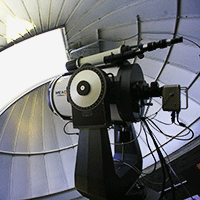Discovering new planets
The finding of new planet Proxima b marks a significant step in mankind’s quest to know if life exists outside our Solar System. University of Hertfordshire astronomers played a leading role in the game-changing discovery.
Proxima b is a rocky, roughly Earth-sized, planet orbiting Proxima Centauri, part of a trio of stars in our neighbouring solar system of Alpha Centauri, and the closest star to our Sun.
The planet is in Proxima Centauri’s ‘habitable zone’, which means it is at a distance from the star which allows temperatures mild enough for liquid water and is therefore potentially capable of supporting life.
This exciting possibility, as well as its closeness to us – just four light years away – makes Proxima b a prime target should mankind ever develop the technologies to travel to a planet outside our Solar System.
Planets that orbit around stars outside our Solar System are known as ‘exoplanets’. Hidden by the bright glare of the stars they orbit, exoplanets are hard to see directly with telescopes.
The momentous discovery of Proxima b [in 2016] was the culmination of many years of observation by an international team of scientists, with key involvement of astronomers from the University’s Centre for Astrophysical Research. This included a series of major observing campaigns, led by Dr Guillem Anglada-Escudé.
“The discovery of Proxima b is another significant step forward for our understanding and knowledge of space and testament to the hard work and scientific endeavour of UK institutions who are making discoveries that could change lives and inspire millions around the world.”
Looking for the ‘wobble’
His Hertfordshire team worked as part of a European Southern Observatory (ESO) project, The Pale Red Dot, which co-ordinated the efforts of more than 30 scientists from eight different countries across three continents.
The astronomers looked for a tiny ‘wobble’ of the star that would be caused by the gravitational pull of a possible orbiting planet. Cool or ‘red dwarf’ stars such as Proxima Centauri are slightly active and can vary in ways that could mimic the presence of a planet. To exclude this possibility, the team also monitored closely the changing brightness of the star.
University of Hertfordshire researchers Dr John Barnes, now at the Open University, and Dr James Jenkins, now at the University of Chile, were able to confirm that the ‘wobble’ being detected was caused by a planet orbiting within a zone where water could exist. This established Proxima b as the closest possible home for life outside our Solar System.
Throughout the project, the team reported the progress of their observations in real time via a website and social media. The findings were later published in the science journal Nature and widely covered by international media.
"If further research concludes that the conditions of [Proxima b’s] atmosphere are suitable to support life, this is arguably one of the most important scientific discoveries we will ever make."
As a result of the ESO campaign, the University of Hertfordshire’s Bayfordbury Observatory now has a major monitoring programme aimed at other nearby stars and exoplanets. It is monitoring stars for EChO, the Exoplanetary Characterisation Observatory, the first dedicated mission to investigate the physics and chemistry of exoplanetary atmospheres.
The Hertfordshire team’s research has already led to further discoveries, such as the finding of four possible exoplanets orbiting Tau Ceti, a Sun-like star 12 light-years away from us.
Their research has also been incorporated into the University’s activities aimed at engaging the public in the excitement of astronomy. The Bayfordbury Observatory hosts talks and telescope viewings, including stargazing via the Cosmodrome, the UK’s largest mobile planetarium.
A feature at festivals and science events, the Cosmodrome’s high definition projector beams galaxies and stars across its six metre-high dome, aiming to inspire the next generation of scientists to learn more about the far-reaching implications of science and the Cosmos.
Bayfordbury Observatory
Bayfordbury Observatory is the University of Hertfordshire's teaching observatory for astronomy and astrophysics. It offers students a hands-on experience with some of the latest technology in the field.
It is one of the best equipped and largest teaching observatories in the country, featuring: seven large optical, individually-housed telescopes, four radio telescopes, solar telescopes in a dedicated dome, a high definition planetarium and an atmospheric instrumentation platform.

